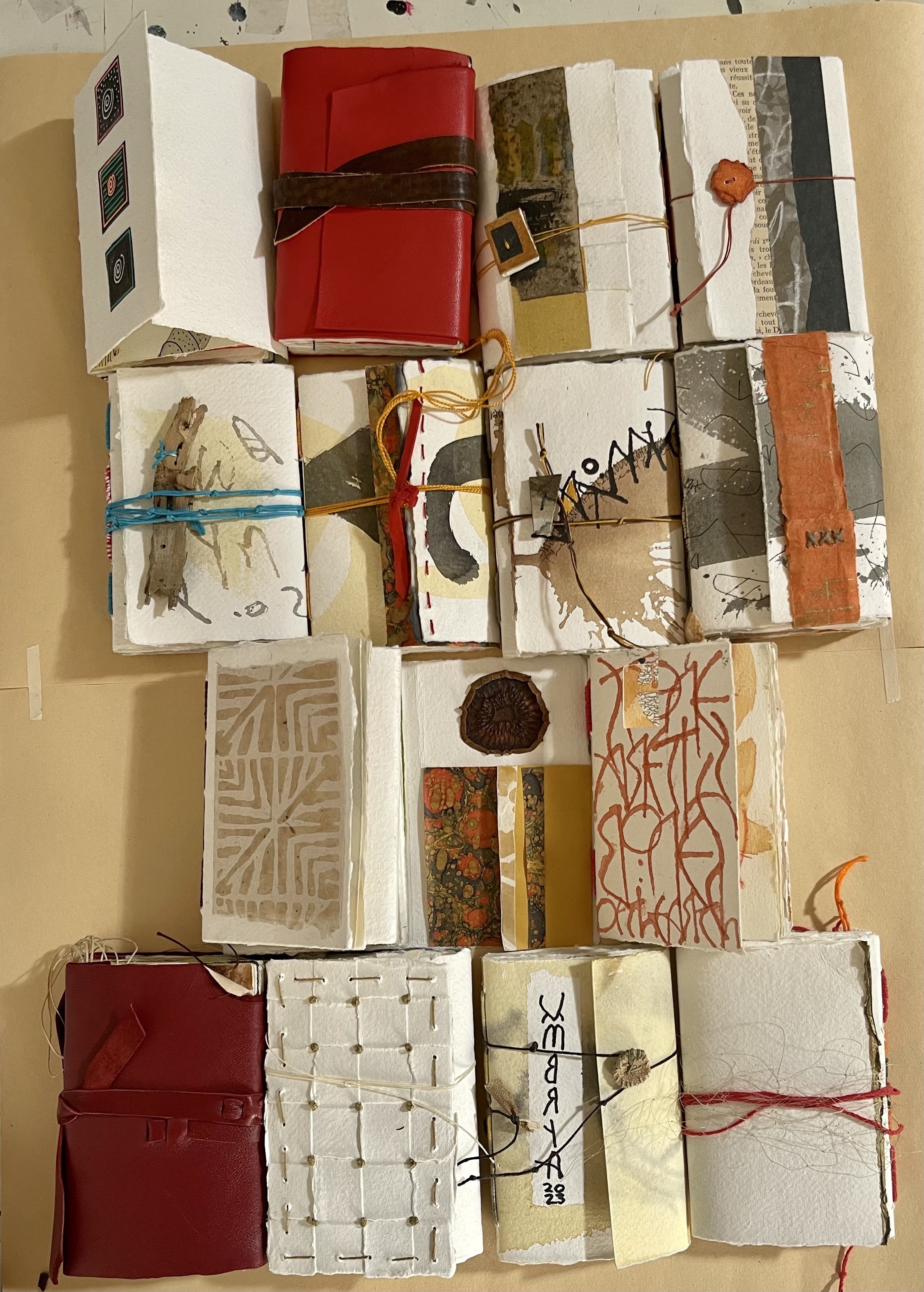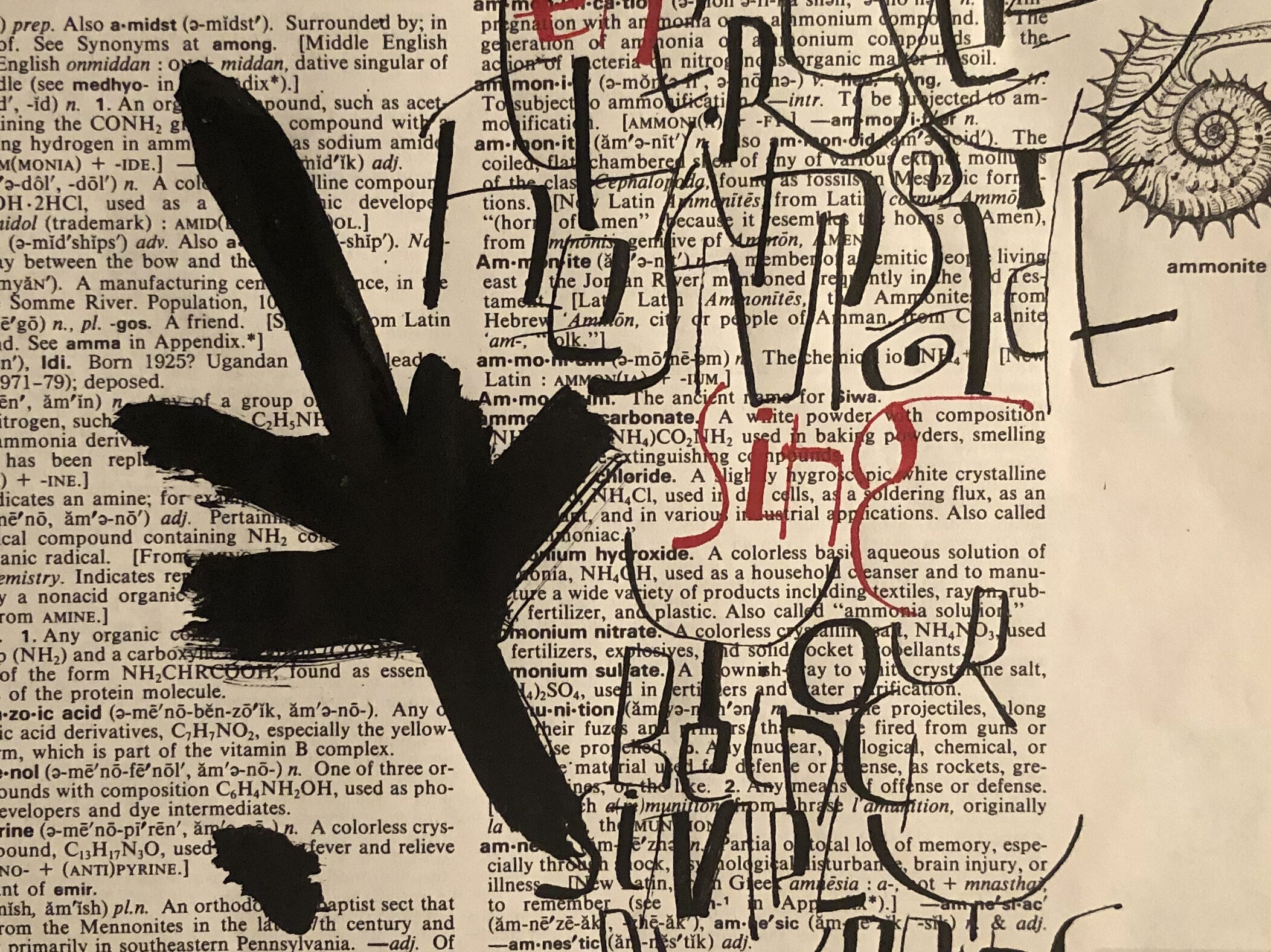
“Do you have hope for the future? Someone asked Robert Frost, toward the end. Yes, and even for the past, he replied”.
There is much more that can be said about Robert Frost’s hope for the future, and, in retrospect, the past. But for now consider that one way of re-kindling hope and perspective is to take a time apart from news and entertainment and open the wide door to imagination, the muse and uninterrupted time. Sometimes you have to go away from the world to enter more fully. Re-fueling and opening to what prompts us was our aim at the recent retreat in Taos, New Mexico. Time moves by another dial and is expanded by all the cross-pollination of ideas in the room. The work that comes has the aliveness of something discovered along the way.

Images from “Winter Seed’s Promise”
I have just returned from a week in Taos, New Mexico, where I taught “Winter Seed’s Promise.” The students collected seeds over the winter, and also on walks on the grounds where we all stay in Taos. The seeds became images of promise, possibility, fragility, curiosity, secrets, and time. Seeds were the inspiration for writing, drawing and painting from beginning students to professionals. There was an international atmosphere in our classroom with French, Italian, American and German students.
Below are lots of images inspired by seeds, and further down is the work with alphabet variations:

“Turn me into song…”
How do you refresh your relationship with what is sacred?
The ancient idea of having a gatekeeper, a guardian for a sacred place, returns at a time when most gates have become porous to continuous interruptions — we are all “on call.” But without the stability of a gatekeeper that protects the threshold as barrier, the lightning-fast change that we are all a part of overruns its bounds, and transformation becomes a superficial commodity.
The kind of work that emerges when everyone agrees to protecting uninterrupted time is unpredictable, powerful, and often a breakthrough for the maker. This is what keeps me teaching — the delight that comes from doing work that you don’t already know how to do, from doing things that may be “ugly” or surprising or unexpected by taking the risk to be unavailable to anyone except the muse, by dipping into the Unknown.
What follows are some examples from the students in my recent class in San Francisco, a magnificent group. The work speaks for itself.

Nulato: “The place we are tied together.” —Koyukon Indian
Stitching the books always reminds me of the place we are tied together. Some part of each person is woven into each book, as a part of each of us was woven together. Being in a beautiful place for a week in a workspace without screens was compelling, it deepened the work, and what you see here is testimony to the budding ability and exuberance of this creative collaboration.

“Make Your Own Bible”
Make your own Bible, is followed by this suggestion:
“Make your own Bible. Select and collect all the words and sentences that in all your readings have been to you like the blast of a trumpet.” — Ralph Waldo Emerson
This idea, along with Gerard Manley Hopkins’s idea of “inscape,” (which I will address later) is what is fueling the theme for my 2023 classes.

Art as Devotion
I had the doors and windows open so that birdsong could come in. I heard the high trill of a melody that comes only in spring, repeated over and over with the passion of a love song. I went outside with my binoculars to investigate. A bird less than half the size of my hand stood in the branches of the tulip poplar, singing his blue heart out.
Indigo is the wrong name, at least now, in the breeding season. He is an impossibly brilliant mix of turquoise, ultramarine and cobalt that covers his entire body. The only indigo is on his wing tips and around his beak. Regardless of what color he is known by, the indigo bunting is dedicated to singing until someone answers, until someone responds to his call. He waits to be answered, and sings and sings. When he sings, it is with every feather; everything vibrates, down to the tip of his tail. He holds nothing in reserve. This is devotion.

What gorgeous thing
I reached for the bacon and found a poem.
It’s Sunday morning; I am making our weekly brunch in the kitchen: southwestern grits with cheese and salsa. Yellow grits that need the final garnish. I open the freezer, and when I reach for the bacon out falls an envelope addressed to no one. Inside the envelope is a sheet of paper with a typewritten poem beginning I don’t know what gorgeous thing the bluebird keeps saying. The poem is accompanied by a tiny songbird feather, smaller than my little finger, that floats down to my feet. The delicate feather of a bluebird fallen from an unaddressed envelope with a poem found next to the frozen green beans.
Wherever the poem with its bluebird song, and a feather, wherever it came from (no one has yet confessed to putting it in the freezer), the day was permanently altered by mystery and gratitude. I consider it another blessing, regardless of how it came to be beneath the bacon. And why not? There is the continuing story of our bluebird house — it sits in full view of our kitchen, and I am thrilled each spring when the pair returns. But last spring the bluebirds were chased off by the house wrens. This was after they had laid four beautiful blue eggs. When the house wrens took over we grieved the bluebird eggs until the day we found a fledgling struggling alone on the ground. This baby bluebird, whose vanquished parents would not return, died in my son’s open palm. We buried his feathered body with its tiny feet, and its lovely beak that will never sing, with my father’s ashes. Three generations in love with winged things.

"Tree, Stone, Eye" | Student Images from Taos
Before I left for Taos to teach the opening classes at the Mabel Dodge Luhan House, I was pushing against the inertia of our long, long sequester. I felt the uncertainty that had grown in many of us about going into the world. I felt the reluctance to move. The poem below made me smile:
My head was heavy, heavy;
so was the atmosphere.
I had to ask two times
before my hand would scratch my ear.
I thought I should be out
and doing! The grass, for one thing,
needed mowing.
— from “Inertia,” a poem by Jane Kenyon
Now I have returned from a few weeks in New Mexico, teaching the classes that had been postponed for almost two years. We were the only ones at the retreat, and the classes were small. The landscape was beautiful, christened with desert showers and new blooming flowers. Everyone had been through something significant in our long period of sequester. There was rejoicing — the fresh newness of being together in a room. This rejoicing was helped along by spectacular food, made by our chef, Sophia, and her team — and good wine.
I began, as always, with the conviction that each student who shows up has a particular gift, and is in class to enliven and strengthen that gift — the seed they were given at birth. Everyone is born with a gift. I believe, and am privileged to witness, that the making of art for its own sake will “bring into realization the self most centrally yours” (William Stafford).

Online Course: Images from "Speak to Me from Everywhere"
Someone said that to not hurry is rest. We all need, as Gottfried Pott said, time under protection of the muse. How do we do this remotely? The paradox for me is wanting to design a course through this screen that sets up a structure for you to work, for a while, without any screens, watches or interruptions. My feeling is that this is a deep need, and essential to creativity.
My first online class is complete, and made possible by all you adventurers out there who decided to jump into this experiment. I am deeply gratified by the sense of participation that was palpable throughout the week.
Each day we worked, through writing, with a different principle of landscape. I want to show you some work from students.

"Our fate restricts us so that our destiny can find us...." — Michael Meade
Our fate restricts us so that our destiny can find us, so that we can find again the gifts we came to give the world and receive the blessing the world would give to us.
— Michael Meade, Fate and Destiny
When something happens that common notions don’t have enough gravitas for understanding, the old stories talk about the “hand of fate”. The Greeks have many stories about prophecies, fate and destiny — and the danger of dismissing the signs.
Now the whole world is tied together by this “hand of fate”. It is as if the planet really is alive with intelligence, insisting that we slow down. Alongside the tragedy of illness and death all around, there is the sense of destiny, of something larger than all of us, forcing us to go inward, or live in trauma.
I have thought a long time about the words, fate and destiny. I am not a Calvinist, I don’t think everything is pre-determined. I believe that every choice matters. And yet, there is this ancient notion of fate as an invisible thread that is woven through all the things of the world and all the events in time. (Michael Meade). It includes an awareness of the limitations we have been given, including death. Fate is the hand you are dealt. Destiny is how you play your hand, how you choose to live into your fate, and find meaning in what you have been given. Your destiny is fully realized because of your limitation. There is an inherent connection between your inner gift and your inner wound. The door is through willingness to be vulnerable, to accept your limitation as a structure that supports your soul’s expression.
